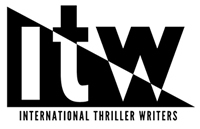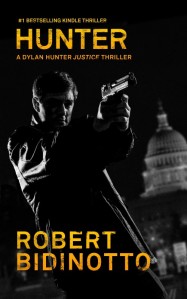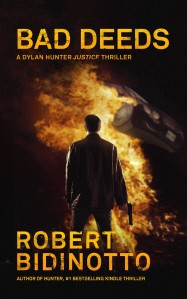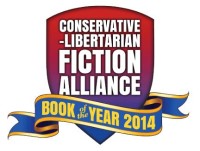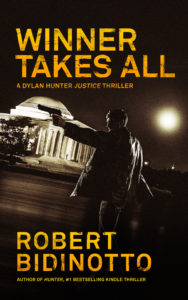I’ve been getting a lot of email from writers who want to know “how I did it.” By “it” they mean: How did I manage to write and publish a debut novel that, without backing by a traditional publisher and with zero paid advertising, went on to become a Kindle bestseller.
Now, the short, unsatisfying answer would be: HUNTER caught the eyes of the Amazon Kindle editors, who (bless them!) singled out my book for week-long focused attention and promotion on the Amazon website. But that merely leads back to a more fundamental question: Why did they single out HUNTER from over a million items in the Kindle Store? Did I do anything that made a difference?
I have no special inside knowledge about why my book was singled out. Nobody from Amazon has ever confided in me. But the following represent my best guesses about their reasons. These are the main things I did to try to make my book stand out from the self-published pack:
1. CARVE OUT A DISTINCTIVE NICHE. To succeed in being noticed in an overcrowded marketplace, you must distinguish yourself and especially your product. If all authors are blogging, tweeting, Facebooking, interviewing, pricing at 99 cents, etc., then there is nothing in that which makes the individual author or his book stand out. Likewise, if you are writing the umpteenth rendition of the same kind of protagonist in the same kind of story, aping other successful writers who pioneered that same sort of character or plotline, etc., you are not standing out from the pack.
John Locke stood out by being the first with 99-cent ebooks, and he did sensationally well. But now, a zillion indies have mindlessly copied him, and as a result, 99-cent pricing no longer stands out or moves ebooks. In fact, it screams “SELF-PUBLISHED!” to readers who have grown leery of quickie, low-quality, self-published titles. Similarly, Amanda Hocking triumphed by being one of the first indies to develop a big social-media following for her books via Facebooking and Tweeting. Now, everyone is doing it—and again, nobody stands out as she did.
To stand out in marketing, you must be first to do something new and different. You must pioneer something. It can be a new twist on an old formula, but it must be sufficient to create a kind of “niche monopoly.” Clancy invented the “technothriller,” a thriller subgenre. Rowling pioneered a parallel race/universe featuring young wizards. Flynn was first in the pool with political thrillers set in the post-9/11 “War on Terror.” Lee Child resurrected and refurbished the “knight errant.” Likewise, I tried to make Dylan Hunter a unique character–a “philosophical tough guy” or “intellectual avenger,” with distinctive, even controversial, ideas and values. And I positioned myself as “the Vigilante Author.” Etc.
Anyone wanting further insights about this should consult the marketing gurus from whom I learned this principle: Al Ries and Jack Trout in their classic book Positioning. That title and their others (including Marketing Warfare and Focus) are invaluable to anyone who wishes his product or service to grab attention amid the sound and fury of a marketplace jammed with countless competitors.
2. THINK LIKE A READER. I love this recent news story about Kerry Wilkinson, a self-publishing phenom who is currently #1 on Kindle in the UK. Read closely what he says about putting himself in the reader’s shoes.
So, if you were a reader in your genre, what would engage you? Apply that consideration to everything you do–from writing, to cover, to formatting, to pricing, to marketing, to websites, to blogging, etc.
Also ask yourself: Who are the readers for my kind of story? Where do they hang out? How can I reach them? What would catch their interest? If you answer those questions before you hit the “publish” button, you’re many times more likely to be successful.
3. CRAFTSMANSHIP COUNTS: NOTHING TRUMPS A GOOD STORY. Authors should spend well over 90 percent of their time and effort not on marketing, but on crafting the best stories they can possibly write.
A great story can sometimes succeed without marketing fanfare; but no marketing fanfare can long sustain a poor story. Catchy covers and pricing gimmicks may win attention for a book, but if that initial attention isn’t eventually affirmed by a positive and enduring reader response, long-term sales will be mediocre at best.
4. PROFESSIONAL PRESENTATION COUNTS. When publishing, an indie author must pay attention to all the “little things” that lend an air of competence and professionalism to his book(s). Covers, design, formatting, logos, your author blog or website–all of these things must exude a quality equal to anything issued or overseen by Random House or Simon & Schuster.
And no, you do not have to break the bank to obtain that kind of quality. I was able to do it all for about $1000. I earned that investment back within the first month of HUNTER‘s publication. And with what I’ve learned subsequently, I probably can publish the sequel for even less.
5. ENCOURAGE ENTHUSIASTIC READERS TO LEAVE “READER REVIEWS” ON AMAZON. Prior to being selected and featured by the Amazon editors, HUNTER had sales that were good but not spectacular. One thing it did have, though, was one of the highest cumulative “customer rating” averages on Amazon–about 4.8 out of a possible 5.
Those customers, let me emphasize, are not predominantly friends and relatives, and no, I did not “put them up to it” in advance. Most are strangers who had emailed me about how much they had enjoyed the book. Whenever that happened, I wrote back and thanked them sincerely. I then asked them to share their enthusiasm with people they knew “and to consider leaving a ‘reader review’ on Amazon, too.” Many of them did, and my book quickly accumulated scores of 5-star raves. I can’t state this for a fact, but I am pretty sure that the Amazon editors took those stellar reviews into consideration before selecting my book for special promotional attention.
6. PAY ATTENTION TO YOUR PRODUCT PAGE. I believe that most authors, and even many traditional publishers, overlook the crucial importance of preparing first-rate promotional copy for a book’s Amazon product page: a compelling product description and enthusiastic blurbs to accompany whatever positive reader reviews the book generates.
Eye-catching covers and attractive pricing, tweets and blogging, online interviews and reviews–such promotional efforts should aim mainly at enticing a curious prospective buyer to check out your book by going to its Amazon page. But that product page is the book’s final sales pitch to prospective customers. Its job is to “close the sale.”
I’m simply astonished that so few authors appear to understand that and to treat what appears on that page as seriously as they should. I spent a great deal of time crafting every sentence of my book’s product description. That, plus the number of positive customer reviews, were probably critical factors in HUNTER being selected by the Amazon editors.
Am I just speculating here? An amusing affirmation of the importance of my preceding points came just a couple of days ago. I noticed that a popular website that tracks and lists self-published bestsellers had omitted HUNTER from its November and December 2011 sales records. I posted a comment about that on the site.
The site’s host wrote back to apologize for his oversight, explaining: “Your book is extremely well prepared. The cover, as well as Avenger Books logo, are professionally designed, and together with a non-99-cent price they turned me to believe the book was published by a newly-born indie publishing house.”
So HUNTER had stood out from other self-published titles so successfully that he mistook it as being a traditionally published book. Which, of course, was exactly what I had intended.
And that, I think, may help to explain why Amazon editors selected it. If not, I think it still explains why so many readers browsing the Amazon product listings spotted my debut thriller and decided to give it a chance.
So that is my “formula” for self-publishing success. In essence, it merely underscores what many successful self-published authors have been saying all along–with just a few tweaks and some common sense (I hope) added. Simple enough to summarize, though hard to execute well. In any case, I hope you find my formula persuasive and useful.

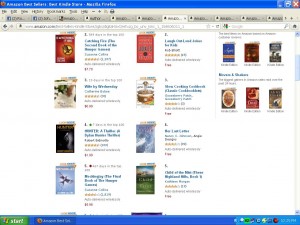
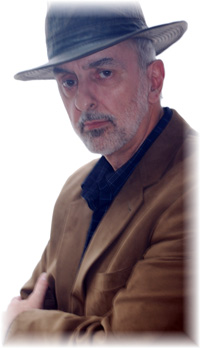 Photo (c) by Debbie Scott
Photo (c) by Debbie Scott
